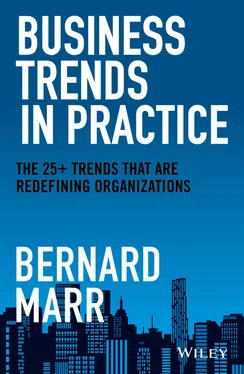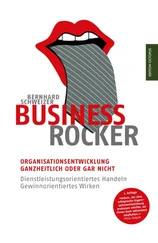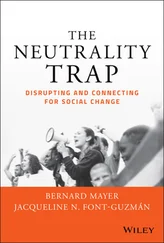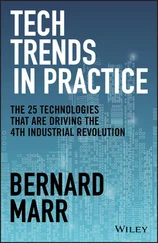Part IIIfocuses on the key consumer trends that are emerging today – trends that will likely prompt a rethink of your products and services, and how to deliver them.
Building on the consumer trends, Part IVis all about key trends that impact how businesses operate internally. In other words, as well as rethinking your products and services, you'll also have to rethink how your business is run.
And in the final chapter, I'll pull these (often interlinked, sometimes disparate, even contradictory) trends together into some broader key lessons and takeaways. These are the things I want to leave you with as you look to the future.
As well as helping business leaders ride the wave of transformation, there is also a loftier goal at the heart of this book. As you'll see in the next chapter, it's not just businesses that are being impacted by these transformational forces; society as a whole is facing enormous changes and challenges. By building better businesses, we can collectively tackle the issues facing our world and create the future we want to live in. If this book plays a small role in that very big task, I'll be happy.
CHAPTER 1 THE FIVE GLOBAL SHIFTS THAT WILL SHAPE THE ORGANIZATIONS OF THE FUTURE
This is a book about business trends. But no business operates in a vacuum. Organizations are constantly shaped by the world around them. And that's why we start our journey here, with some of the biggest trends emerging in politics, economics, and society.
In this chapter, I outline five major global shifts that business leaders must take into consideration as they plan for the future. This is not just a “nice to know” chapter; these trends have very real business implications (you'll find some practical lessons at the end of the chapter). Each global shift outlined in this chapter indicates where future business opportunities may lie, meaning the most successful organizations of the future will be those that address and move with these shifts. The flip side, of course, is that these global shifts also pose risks for businesses, particularly the risk of being left behind. As a result, many businesses will end up sidelined, overtaken by their more forward-thinking competitors.
What struck me as I was writing this chapter is that many of these trends are contrasting. For example, we're seeing a trend toward cultural convergence at the same time as growing divergence, which, on the surface, is a bit of a head-scratcher. Perhaps one feeds into the other. Or maybe it's simply a sign of the confusing, uncertain world we live in these days. One thing is sure: businesses will have to contend with some trends that are seemingly pulling in different directions. Adapting to this new age of uncertainty may mean rethinking what your business offers and how it is run (more on this in Parts IIIand IVof this book). For now, let's immerse ourselves in five of the biggest global shifts that are emerging, starting with our relationship with our planet.
Trend 1: Our Changing Relationship with Our Planet
To put it mildly, we've not had the best relationship with our planet. We've chopped down forests, burnt carbon, dug mines, polluted waterways – all in the name of growing prosperity. For Western countries at least, this has paid off. Using our natural resources has led to greater prosperity. But it has also led to climate change, the collapse of ecosystems and loss of biodiversity, chemical and plastic pollution, and the decline of our natural resources (particularly water). As a result, our planet is under immense pressure and showing the strain through abnormal weather patterns and natural disasters, which, in turn, create pressures around crop production, food security, migration, and more.
Some food for thought on the emerging climate crisis:
Climate change is happening so quickly, many species are struggling to adapt. The Intergovernmental Panel on Climate Change says that a 1.5°C average rise in global average surface temperature may put up to 30 percent of species at risk of extinction. Push that up to 2°C and most ecosystems will struggle. 1 For context, the temperature has already increased by 0.9°C since 1906 (the figure is even higher in polar regions). 2
By the end of this century, 150–200 million people could be forced to migrate from land that will be underwater. 3
Some of the biggest sectors in terms of greenhouse gas emissions include agriculture and forestry (responsible for 18.4 percent of global emissions), energy use in industry (24.2 percent), energy use in buildings (17.5 percent), and transportation (16.2 percent). 4
Our precious resources are under enormous pressure. Fresh water makes up just 2.5 percent of the world's total volume of water (and half of that is ice). So it's perhaps no wonder that 1.8 billion people are already living with water scarcity. Even more worryingly, 5.2 billion people are expected to face water stress by 2025. 5
Competition for land (particularly land for agriculture) is also growing, and many countries such as China and Saudi Arabia are already pursuing land in Africa. Global competition for finite resources, including land and water, is only going to increase as the population grows.
There may also be a global fight for rare earths, some of the most important minerals and metals found in the ground, which are used in everything from lithium-ion batteries to electric cars. The US is 80 percent reliant on China (the world's biggest rare earths producer) for rare earth imports, and this could lead to further strains on political relationships in future. 6
To keep pace with the growing population (I talk more about global demographics later in the chapter), an often-quoted statistic is that we'll have to double crop and animal production by 2050. More conservative estimates suggest that, as food production has already increased in recent years, we may only need to increase production by between 26 percent and 68 percent by 2050. 7 But that's still a significant increase to accommodate on an already struggling planet.
Plastic pollution is another pressing concern. Single-use plastics account for 40 percent of the plastic produced every year, meaning something that may be used for mere minutes ends up hanging around for hundreds of years. Every year, around 8 million tons of plastic waste finds its way into the oceans (the equivalent of five garbage bags of trash being placed on every foot of coastline around the world), and with plastic production expected to double by 2050, the problem is set to get a lot worse. 8
If our relationship with our planet was a romantic one, it would be labeled “toxic.” Earth's best friends would probably be telling her she could do better. And we must do better. We need to build a more balanced, sustainable relationship with our planet.
Yet the emerging climate disaster is probably the biggest challenge we've ever faced. So how do we overcome something of this magnitude? In his book How to Avoid a Climate Disaster , Bill Gates says that we're adding 51 billion tons of greenhouse gases to the atmosphere every year. To stop global warming and avoid the worst impacts of climate change, Gates says we need to get that number down to zero by 2050. Let me say that again: zero.
The problem, of course, is that most zero-carbon energy solutions cost more than their fossil fuel counterparts. (Gates refers to the price difference as “Green Premiums.”) He says that using Green Premiums as a decision-making tool can help us decide which zero-carbon solutions should be deployed now, which nongreen goods should be priced higher, and where we need to invest in new innovations because the current zero-carbon alternatives aren't cheap enough. (Some of the innovations Gates promotes include nuclear fusion, sea-based carbon removal, and direct air capture of carbon.)
Читать дальше












